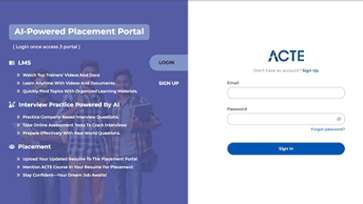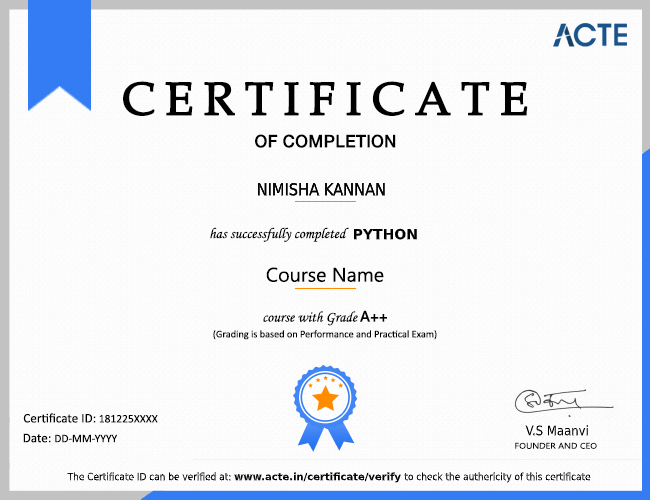The rapid advancement of technology has led us to leave these routine and repetitive tasks to robots. In the day to day we find that we have to extract data from a web page, and insert it into an Excel and send several reports, as the volumes of processed data increase, these repetitive tasks become tedious and stressful, but it is possible transfer that task to robots thanks to Robotic Process Automation and dedicate ourselves to activities that generate value for the business such as sales statistics or analysis of supplier data.ACTE, has developed this course to make known the possibilities of RPA technology, in addition to covering the techniques and tools to learn to identify and prioritize processes to automate, up to the design of architecture. At the end, the participant will be able to apply to the international Automation Anywhere® Certified Advanced RPA Professional exam.Start Learning with us ACTE Robotic Process Automation (RPA) Classroom & Online Training Course.
The growth of the industry and widespread adoption of RPA will drive job growth as well. Many types of jobs are available in RPA, including developer, project manager, business analyst, solution architect, and consultant. This is fact, going to be the future and most important thing in the coming years. RPA in the future is going to incorporate the following things: Incorporating AI for advanced decision-making and inferencing.
Meanwhile, there are so many good opportunities are been involved in the future scope of RPA can be observed in the field of data entry and data rekeying jobs. These tasks could easily automated with RPA. The various repetitive tasks such as formatting, data assembling or anything, which requires a series of steps, that can easily carried out with the help of RPA. RPA will definitely become the next revolution in technology and you will surely find thousands of jobs opening every year. There are more than 5 million jobs awaiting you, right now.
However, robotic process automation (RPA) anticipated evolving and soaring over the forecast period. The modern enterprises need robotic process automation for faster implementation, execution, and scaling. Technological advancements have triggered businesses to overcome new challenges aimed to cope with changing consumer demand and requirements. In the recent past, the adoption of robotic process automation has captured the attention of many SMEs and large enterprises. This can be able to attribute to RPA’s ability to deliver seamless operation coupled with significant value addition from the resources.
We are happy and proud to say that we have strong relationship with over 700+ small, mid-sized and MNCs. Many of these companies have openings in Robotics. Moreover, we have a very active placement cell that provides 100% placement assistance to our students. The cell also contributes by training students in mock interviews and discussions even after the course completion.
Absolutely it’s an future field where, According to Forrester Research (Nov 2015), up to 9% of the global workforce will be threatened by RPA software in the near future. The change is coming, and it is up to process improvement professionals to prepare for this disruption by properly educating their corporations on the do’s and don’ts of RPA. Robotic process automation (RPA) been heralded as the next big thing in process management. Google Trends reports show that the last 2 years have seen a peak in interest in these technologies.
The Difference between Robotic Process Automation and Artificial Intelligence. RPA is a software robot that mimics human actions, whereas AI is the simulation of human intelligence by machines. RPA is a technology that uses specific set of rules and algorithm and based on automated a task. Mean While AI is focused more on doing a human-level task, RPA is practically a software that reduces human efforts — it is about saving the business and white-collar workers' time.
Robotics Process Automation (RPA) allows organizations to automate task just as a human being was doing them across application and systems. ... RPA does not require the development of code, nor does it require direct access to the code or database of the applications. Initially, coding skills are not required. However, if you want to learn more of RPA, at least one programming language would be required to extend the existing RPA functionality. There are no prerequisites for Automation Anywhere. No coding is required..... Automation Anywhere empowers organizations to automate the processes that has been executed by the humans.
Our courseware is designed to give a hands-on approach to the students in Robotics Automation. The course is made up of theoretical classes that teach the basics of each module followed by high-intensity practical sessions reflecting the current challenges and needs of the industry that will demand the students’ time and commitment.
In 2020, RPA is going to claim its place as a central platform for other enterprise automation tools. RPA has been around for the last few years and has advanced considerably. It can manage any types of tasks that are repetitive and predictable. It frees up the resources to focus on tasks that require creativity, decision-making and judgement. As per Forrester, RPA Market will reach $2.9B by 2021.
The future certainly belongs to RPA, and workforces around the world are investing heavily in this efficient technology to fast-track organizational efficiency, effectiveness and profitability. Nonetheless, global robotic process automation has come a long way since 2016. At the time, RPA software purchases amounted to $73 million. This increased to $113 million in 2017, $153 million in 2018, and $192 million in 2019. In 2020, HFS Research estimates that this figure will rise to $232 million and by 2021 to $272 million. These projections indicate that there is strong growth in RPA adoption in the global market. RPA services have increased rapidly since 2016, rising from $198 million, to $630 million in 2019. By 2021, that figure is expected to rise to $952 million. Experts roundly agree that RPA is the future of IT automation
The growth of the industry and widespread adoption of RPA will drive job growth as well. Many types of jobs are available in RPA, including developer, project manager, business analyst, solution architect, and consultant. People are often concerned about robotic process automation taking jobs away from real people. But a lot of companies who need manual data entry already aren’t hiring local employees for those tasks. They’re outsourcing their data entry overseas. Since the bots would be managed/hosted here in the USA, using RPA actually repatriates jobs.
Career Scope in RPA
Future Scope for RPA:
RPA’s future scope is huge and wide. The future of RPA will incorporate the following things.
- With RPA, a set of protocols can be used in every computer-aided process.
- RPA is considered to be the replacement of the data rekeying and data entry jobs with its techniques and tools.
- Also, it replaces the repetitive jobs of formatting tasks and data assembling.
- It incorporates Artificial Intelligence for advanced inference and decision making.
Benefits of RPA:
Accuracy: Robots perform actions like humans but without mistakes and errors.
Efficiency: Robots improve the overall efficiency of the manufacturing process. Unlike humans, they do not get tired.
Change Management: RPA performs change management as it reverses the data integrity.
Cost Reduction: Software robots reduce organizations’ costs.
Monitoring Compliance: Robots offer detailed audit logs by allowing enhanced compliance.
RPA Tools Include:
Below are some of the RPA tools:
- Blue Prism
- Automation Anywhere
- OpenSpan
- UiPath
Blue Prism:
Blue Prism is an RPA tool that enables business operations to be agile. It’s a scalable and secured tool to automate clerical back-office processes by developing a digital workforce. Blue Prism is a set of run-time environments for Robotic Process Automation in which it has two main parts: Object Studio and Process Studio. Object Studio creates Visual Business Object (VBO) without having the main page. Still, it allows two default pages, whereas Process Studio is a traditional flowchart in which creates the actual process and allows control loops, business logic, and variables.
Automation Anywhere:
Automation Anywhere is a popular vendor in RPA which offers powerful capabilities to automate complex tasks. This tool combines Robotic Process Automation with conceptual elements like reading unstructured data and natural language understanding. Automation Anywhere is a web-based management system to run automated tasks and end-to-end business operations. Automation Anywhere consists of three primary components: Bot Creator, Control Room, and Bot Runner.
OpenSpan:
Openspan is a screen scraping automation tool containing a single SignOn interface. It reduces the toggle between different windows/applications and automates the manual processes like copying and pasting web applications. This tool helps to derive the results very accurately and provides instructions based on Openspan studio to create automation projects. OpenSpan studio delivers a unique, rapid, and intuitive visual development environment to complete tasks more efficiently.
UiPath:
UiPath is an advanced RPA tool that allows the automation of repetitive tasks and enables in a visual manner (through diagrams). UiPath contains less code like a scripting language and .net. We can create workflows even without knowing the code.
It provides deployment management, remote execution, access control, execution monitoring, process modeling, auditing and work queues to distribute transactional process load among the Robots.
Scope of RPA Course:
- The Robotic Process Automation scope is enormous and immense.
- RPA plays a vital role in the coming years because it will replace repetitive tasks and data entry jobs.
- The field of Artificial Intelligence includes innovative knowledge of job implications and decision making. In the banking domain, RPA impacts excellent prospects in transactions and calculations.
- It shows the consequences of aircraft manufacturing, automobiles, and other leading-edge technologies. Concerning Robotic Process Automation, humans perform many tasks like collaboration, reporting, planning, controlling, managing, and so on.
- Many of the automation tools like UiPath, Blue Path, Automation Anywhere and OpenSpan were already being used in many organizations.
- The candidate who wants to build his/her career in the RPA field can choose any of these tools in the implementation of automation.
- A Career in the RPA field is very effective. When compared to other fields, the skill sets in RPA are higher. Surely RPA will create a massive revolution in technology and creates immense job opportunities.
How to Get Started with RPA Course?
The career expectations in the RPA field are very high.
Employers are always looking for individuals with good knowledge and skills.
To start in RPA field, one should have the following checkpoints:
- Candidates should have excellent knowledge in Microsoft Office, MS-Excel, Access, and other Macro applications.
- Should have proper orientation and in-depth knowledge in programming languages like C, C++, Java, JavaScript (while handling web applications), J# at the coding stage.
- There should be good knowledge of writing codes as per the ascertained coding standards.
- Must have proper orientation of SOLID principles to develop a responsible delegations and quality layout process.
Apart from the above skills, one must be highly enthusiastic about his/her career in the RPA field. Also, undergo with right kind of training and acquire in-depth knowledge in Robotic Automation.
Technical Responsibilities:
- A candidate who takes-up a position in the RPA career path must work predominantly with RPA principles and conventions on Business Process Automation.
- Build the Business Process Framework by understanding the future scope of robotics.
- Deploy and develop automation products in collaboration with global teams.
- Customize and create Automation solutions.
- With the support of existing processes, guide “Change Management Process” and implement updates.
SO?
- For a long time, it has been observed that Robotic Process Automation is evolving as a troublesome technology.
- With its super technology, RPA provides many benefits such as fast production, increases quality, improves customer satisfaction, and reduces the cost.
- Such advantages cannot be ignored. By the year 2024 RPA market will reach USD 9 billion. It is expected that in future RPA will going to be used in various domains and will be utilized in industries such as insurance, aviation, manufacturing, banking, and many more.






























